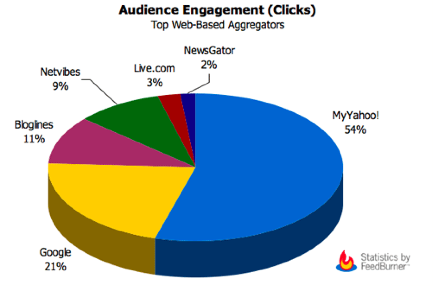Over the weekend there was a huge buzz over new RSS subscriber numbers that Feedburner was reporting due to a change in how Google Reader was reporting their stats. The bounce was reported as high as 250% by bloggers like Jeremy Shoemaker to more average bounces of around 30% by bloggers like Stowe Boyd. My own bounce was 32%. The change has prompted many to begin to re-evaluate assumptions previously held for a long, long time. One of those was my own boss, Jeremy Wright, who mused, “Google is now, or is soon set to be, the world’s #1 feed reading software / destination / feature.”
Without losing the forest through the trees, FeedBurner has just let loose with some blistering analysis of the trend. And they are spot on. While the assumption is made that bigger is better, Feedburner examines the data and arrives at the conclusion that the motion of the ocean is actually significantly different.
Not all subscribers are alike. Yahoo reports active subscribers over a rolling 30-day period. Most other web-based readers report the total number of individuals who’ve subscribed, regardless of whether they have actually logged in recently.
Default feeds are popular. (Yes, this is an early frontrunner in 2007 “Painfully Obvious Bullet” balloting.) Said differently: many aggregators offer a set of default feeds for every new account, or provide “bundles” of feeds by category. These feeds will get disproportionately high subscriber numbers at specific aggregators.
 Point taken. Subscriptions don’t mean a damn thing if people aren’t actually engaging in the feeds. Since engagement is seen as actual clickthroughs, is it more important that feeds be subscribed to or read. Raise your hand if you skim headlines in your RSS reader? Me too, actually.
Point taken. Subscriptions don’t mean a damn thing if people aren’t actually engaging in the feeds. Since engagement is seen as actual clickthroughs, is it more important that feeds be subscribed to or read. Raise your hand if you skim headlines in your RSS reader? Me too, actually.
Which begs the question. Are subscriptions that are not read any better than the Movieline magazine I get in the mail and throw away?
An interesting data point from the FeedBurner report reinforces an argument that has been argued, particularly in the Full Feed/Partial Feed debates, for awhile. The analysis of audience engagement (clicks) shows that the largest number of clicks come from MyYahoo! which displays only headlines. Hear, hear for teasers!
This report is really an eye opener for me. There’s lots more juicy information in it that I can’t even begin to relate here. Go read it for yourself. However, it strikes me how many assumptions have been made and how ingrained the assumptions are and how wrong we actually are on so many different fronts. If the data in this report is valid, which I presume it is as close as it can be, Bloglines is pretty much insignificant. It’s significant in that it carries 33% of the web-based RSS subscribers, but when only 11% of subscribers convert, it becomes purely insidious as a reader.
I wonder, really, how our strategies will change as assumptions fly in the face of reality. I also wonder how many people cater to their RSS audience and encourage engagement from those readers. I personally have taken to better headlines and strategic first paragraphs as recommended by people like Brian Clark and following other good-practice techniques. It seems those great headlines convert pretty well and I don’t even have to pay attention to which reader they are using.
What will you do in light of these findings?
